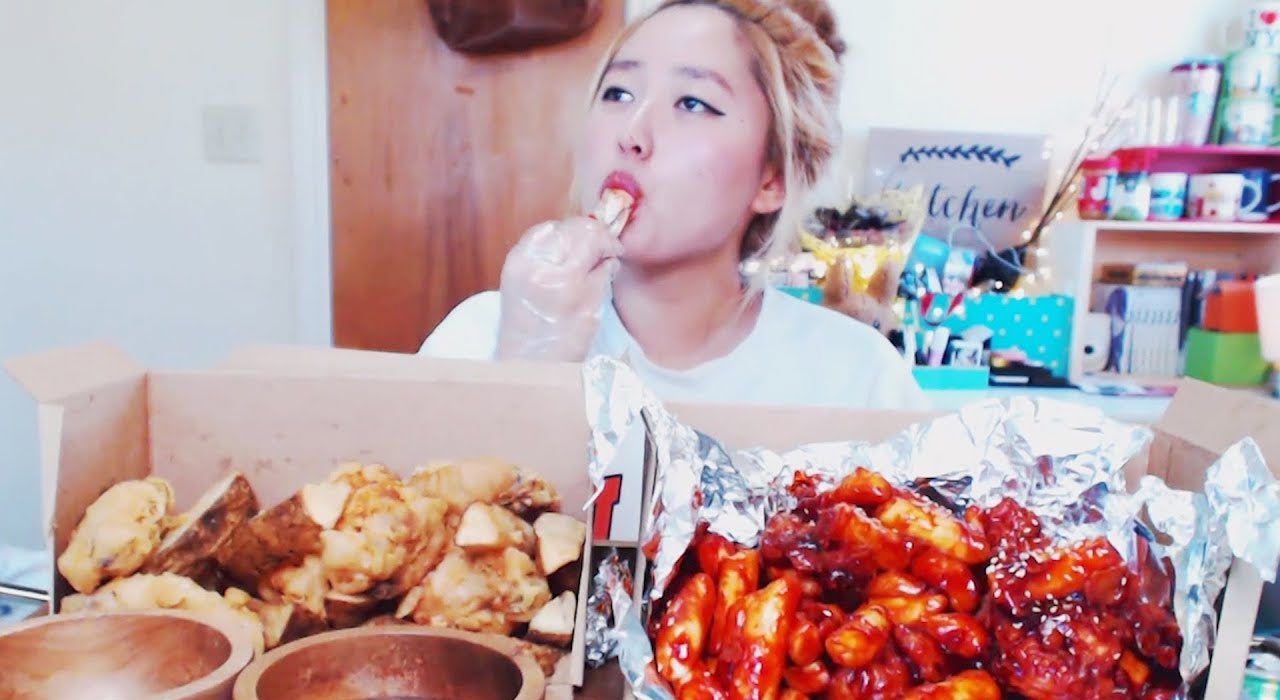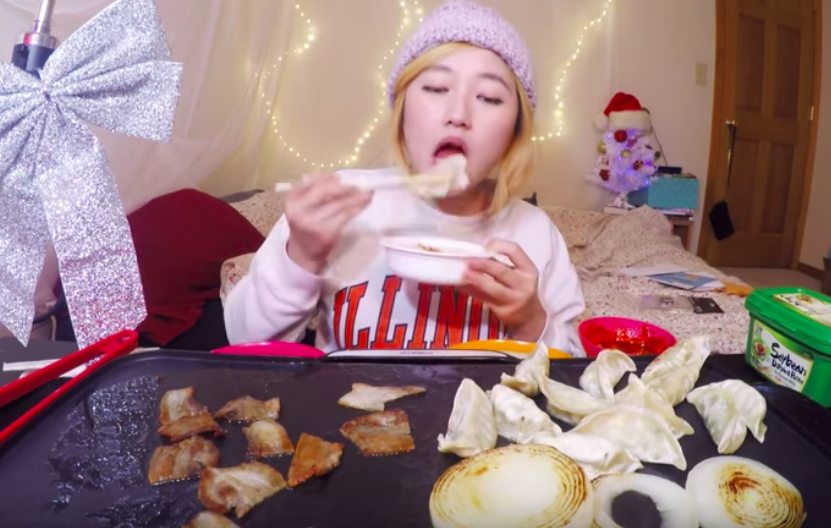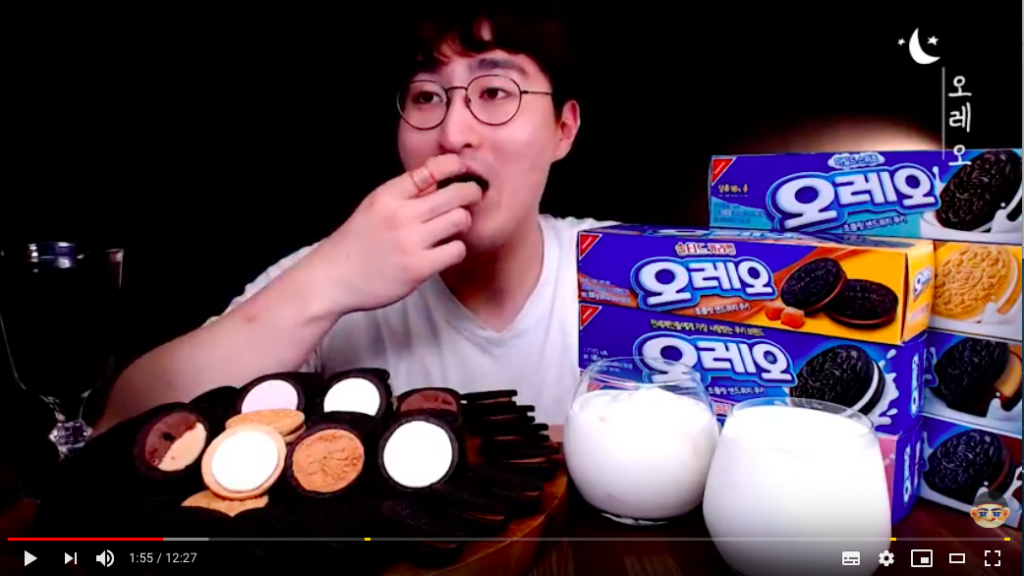WTF is Mukbang and Why Should You Watch these Viral Korean Videos? An Explainer
Slurping, chewing, chomping, and binging. Would you watch others scarf down large platefuls of foods?
Thousands of people are watching these Korean videos, called “mukbang.”
What’s a mukbang? It’s a YouTube trend from South Korea that started around 2010. In a mukbang video, the YouTuber or BJ (“Broadcast Jockey,” a unique-to-Korea term for a vlogger) eats loads of food while narrating and interacting with their audience. While the craze started in South Korea, it’s migrated across the world.
Here’s how it’s trended on Google search over the past five years:

And believe it or not, these food-crazed YouTube stars are making a lot of money eating food!
If you’re ready to dive deep into the world of mukbang, then here’s what you need to know about the viral Korean trend.
What is Mukbang??
If you’ve heard about or stumbled across a mukbang video, you may have several pressing questions on your mind. What does mukbang mean? How do you define mukbang? And why is it called “mukbang” in the first place?
Well, mukbang is a portmanteau word (a mix of two words smushed together). It comes from muk-ja for “eating” and bang-song for “broadcast.” So, mukbang means “eating broadcast.”
The mukbang pronunciation is a bit tricky to get right. Most Western Mukbangers pronounce it exactly as it looks: “muck-bang.” But, in Korean, it’s pronounced “mook-bong” or “moak-bahng.” You’ll also see it romanized sometimes as meokbang.
Mukbang is usually defined as a live-streamed eating show where the host binge-eats. But it can be more than that. Sometimes, the host cooks the food on camera first, then eats it. Some videos feature noisy sound effects and descriptions of the food, while other videos show the host eating quietly. They almost always show the host throwing down food like it’s a food eating contest. But sometimes they only eat something small and delicious.
Mukbang are usually live-streamed on a Korean platform called AfreecaTV. Viewers can leave comments in real time and encourage the host to eat more or mix it with something else. But it’s since migrated to other video and streaming platforms, like YouTube. There you’ll find Mukbangers all over the world who have uploaded videos instead of sharing live.
If this seems strange and confusing, it’s basically the food porn version of a “shopping haul” video. These types of videos have trended for years on YouTube where the vlogger pulls out all their shopping bags and shares their “haul.” They go through each item and why they bought it.
It’s also not that different from American cooking shows, and the enjoyment we get from those. The difference is, in America, the priority is on the process of cooking with only a little time at the end where the host actually tries the food. In South Korea, cooking shows actually spend much more time showing the host eating the food after cooking.
And thus, mukbang came into popularity, where the host shares their “food haul.” They’ll share where they got it, and then eat it while viewers watch on.
And their audiences do watch — for as long as an hour!
All That Noise! All That Food!
One of the biggest aspects of mukbang is the noise. They purposefully use exaggerated noises to capture the sounds of eating, drinking, biting, chewing, and more. While that can be uncomfortable for some (it is for me!), this is another growing genre of video trends: ASMR videos. ASMR stands for “autonomous sensory meridian response.” That’s a fancy way of saying you enjoy relaxing to the sounds of every life, from the sound of eating to the sound of brushing hair.
You can see this in action for yourself here:
What’s interesting about Korean mukbang videos is they are funded by audience donations. YouTubers in America make their income through ad revenue and sponsorships. Korean BJs make most of their money while live-streaming and being sent “gifts” or donations of money.
And most of these hosts, especially native Koreans, are attractive and thin, which is part of the appeal. Since the BJs consume as many as 4,000+ calories in one sitting, many of the hosts go to extreme lengths to make up for it. One mukbang star, Banzz, has said he exercises up to 12 hours a day to keep his weight down.
Despite that, the trend keeps growing with more people who think mukbang is worth it for the followers.
How did Mukbang Originate?
What is the purpose of a mukbang and how did it originate? Mukbang originated on the live-streaming platform AfreecaTV in 2010.
It grew in popularity because it’s a stark contrast to Korean societal and gender norms, as well as food etiquette.
Food culture runs deep in Korea. And many people theorize mukbang began thanks to increasing loneliness of single Koreans in a digital age. In South Korea, eating out is mostly a social activity, and it’s rare to eat alone. But, with a growing number of Koreans living alone, they became lonely and turned to social media. So, this may be a reason why Mukbangers began to film themselves for others, and why viewers enjoy watching them eat. Especially live, where they can leave comments and interact.
This isn’t strange in Korea since mobile streaming and digital services like WiFi are so much more advanced. They’re always able to get the highest quality content at the touch of a finger. It’s changed the way social interactions happen. So some think that mukbang is an example of the digital shift away from traditional, person-to-person social activities.
That said, you also have to consider the deep-rooted history of food for Koreans. As this Korean blogger points out, it may have less to do with loneliness and more to do with enjoyment of seeing someone else’s enjoyment. And like anywhere in the world, people enjoy watching others enjoy the food they made. It’s a simple joy to take happiness from watching someone else be happy.
Plus, shortages of food from the wartimes are still very present in the minds of many Koreans, even though there is plenty of food now. They still remember those times or remember hearing about it from relatives, and their food culture has been shaped by that. And now, South Korea has an obsession with health and maintaining a thin weight. So, why mukbang is popular comes down to enjoying what they once did not have, and satisfying their own cravings by living vicariously through others.
In fact, that last point became such a worry by the Korean government, that they issued a health warning against mukbang. Worried about food disorders from both extreme binging and extreme deprivation through watching others eat, the government set guidelines for mukbang shows.
The Mukbang Challenge
Once it hit the West, mukbang became more commonly known as the “Mukbang Challenge.” These YouTube video shows share people eating tons of food in a certain time limit. It takes mukbang and adds a food eating contest aspect to the videos. Sometimes the challenge is less time based and more quantity or intensity based, like eating a ridiculous amount of spicy noodles.
The Mukbang Challenge usually features ramen or other large noodle bowls, where the host eats anywhere from 5 to 15 packets of noodles. Get ready for lots of slurping!
How to Learn Korean with Mukbang
So how do you use mukbang to learn Korean? Well, mukbang can actually be a useful tool for learning. It often features young, trendy hosts using the most current slang and language.
You’ll pick up how to describe food in painstaking detail, and you’ll never forget your vocab for the food after this. Plus, the uniqueness of mukbang makes it stick in your memory more than hearing it from a textbook. The specific topic (food and eating) gives you easy context to infer words. That makes it simpler to listen and understand than, say, a popular K-Drama.
One of the first places you can start when learning Korean is 90 Day Korean Inner Circle. It’s the best way to learn Korean fast, having a conversation in as little as 90 days. And you’ll use the 80/20 principle to memorize all the essentials of the language to get you going. They even have a module dedicated to learning slang and understanding dramas and videos like this. So it’s perfect to prepare.
Then, you can find the best mukbang videos and live-streams at AfreecaTV. Since this is where it all started, it’s where you’ll find the most current trends.
But, there’s also mukbang channels on YouTube to check out. Mukbangers like:
When watching the shows, try to watch once without any help. Then you can try turning on subtitles in Korean to help you understand (especially if their mouth was full!). Look up words you don’t know, and then try saying out loud to yourself what happened in the video. What did they eat? How did they describe the taste? This way, it sticks in your memory!
A Few Mukbang Phrases to Know
You know all about mukbang now, so let’s prepare with some food vocab and phrases. Here are some to get you started:
- 식사 (sigsa) – Meal
- 반찬 (banchan) – Side dish
- 식품 (sigpum) – Food
- 음주 (eumju) – Drink
- 해물 (haemul) – Seafood
- 고기 (gogi) – Meat
- 돼지 고기 (dwae-ji gogi) – Pork
- 김치 (kimchi) – Kimchi
- 야채 (yachae) – Vegetables
- 국수 (gugsu) – Noodles
- 잘 먹겠습니다 (jal meoggess-seubnida) – “Bon appetit”
- 잘 먹었습니다 (jal meog-eossseubnida) – “I ate well”, “The meal was good” or “Thank you for this meal”
- 배고파 (baegopa) – “I’m hungry”
- 나는 전체 해요 (naneun jeonche haeyo) – “I’m full”
You’ll also want to know your Korean greetings like 안녕하세요 (annyeong haseyo), because most videos start out with these phrases.
Over to You!
Is mukbang your style? Do you enjoy these audio-sensory videos to learn Korean? It’s a different change of pace from other popular Korean shows!
If you’re ready to learn more Korean, check out our favorite online Korean resources and 90 Day Korean Inner Circle to make the most of your Korean fast.
다음 시간까지!! (Daeume sigankkaji, “Until next time!”)






Social